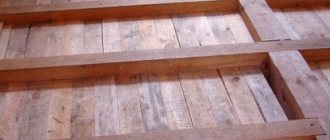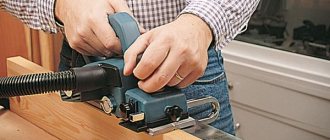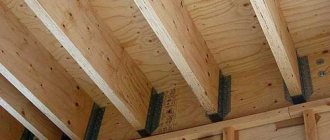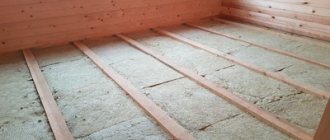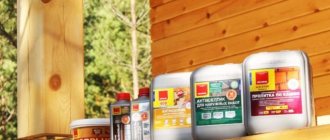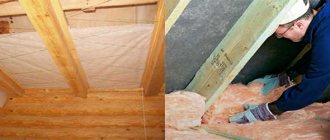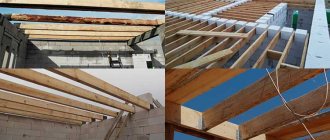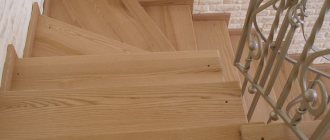When building a roof, special attention is always paid to the structure of the attic. After all, it is important that its covering is done technologically correctly, does not put unnecessary pressure on the walls and is able to withstand the load from things stored under the roof and sometimes an entire set of furniture.
Therefore, in this article we will understand in detail how an attic floor on wooden beams should be installed correctly: the features of its installation, calculation of loads and fastening. And our detailed illustrations will help you.
What is an attic ceiling?
The ceiling is a horizontal load-bearing structure that separates the living floor from the attic space, and at the same time takes on the load from the weight of everything that is under the roof.
The floor itself is a necessary element of rigidity, which also provides stability to the entire structure. Among all the others, today we will highlight the attic floor, namely its specific type. Note that the general rules apply to all types, but there are still some technical features in the arrangement of attic floors along beams.
The first of these is rigidity and strength. Those. the overlap should be:
- Capable of withstanding design loads and not bending or collapsing. For example, the permissible deflection is only 1 in 250 of the span length.
- Secondly, the attic floor should not be flimsy, and in no case should it vibrate when objects are moved on it or people move on it.
- And finally, soundproofed to avoid unpleasant squeaks when someone climbs into the attic.
In private construction, two types of floors are mainly used: wooden and reinforced concrete. The former are built on strong wooden beams, and the latter – on beams, slabs and in a monolithic version. Also, the beams themselves can be steel if it is necessary to cover fairly large spans. But it is precisely in private housing construction that the choice of flooring material is most often influenced by the economic factor.
The cost of installing floors usually amounts to up to 20% of the estimate for the entire construction of a house, and labor costs - as much as 25%. Therefore, the construction of a wooden attic floor is still quite popular - all thanks to its high performance characteristics and good sound insulation.
And one more important point: when making wooden attic floors, you do not need heavy lifting equipment, especially a concrete pump.
How and with what to fasten: types of fasteners
Regardless of what structure the beam is attached to (to a wall, mauerlat, reinforced belt), fasteners are presented in the following most popular variations:
- Bolts. Here, large factory products are used, produced in accordance with GOST standards, in the form of wood grouse, or ordinary wide bolts, tightened with large nuts that are suitable in size.
The capercaillie can be screwed through the beam along the top of the wall structure using a special ratchet wrench.Holes in I-beams and channels also serve as fasteners for bolts. The standard product cross-section is 25 (mm), but it can be increased, as can the length of the products, which starts from 28-30 (mm).
- Sidebar .
This type of connection to a part of the wall is most suitable for wooden beams. It is important here that the end of the beam fastening does not extend beyond the outer wall. It must also be wrapped in waterproofing material to protect it from temperature changes and the ingress of condensation and moisture. The insert itself is a chopped connection, which is carried out according to pre-marked markings. Builders call the insertion process the formation of a “dovetail,” since a kind of wedge is formed in the wall structure. - Cutting . The difference between this process and tie-in is that it runs the entire length of the wall, while the beam extends somewhat beyond its limits. The cutting technique is most used in cases where large spans need to be covered with beams. The cutting process is not complicated and requires the simplest carpentry tools.
Bolt-on mounting:
Connection type - insert:
Notch mount:
Fastening to plates using anchors and bolts is the most common connection, since it is applied directly to the logs wrapped in waterproofing, and clings directly to the load-bearing walls and reinforced belt, often being a continuation of the Mauerlat.
Advice . Wooden and metal beams can be secured with anchors. Reinforced concrete beams are laid on a poured cement mortar, and, if there are lateral end ends of the reinforcement, they are welded to the rods of the wall structure.
Advantages and calculation of beam floors
The entire structure consists of beams and boards, which are called rough. The beams themselves can be load-bearing, located simply next to each other, or fixed in a special way, which is much more reliable. The standard sizes of beams are 20-40 centimeters in height and 15 meters long, plus 8-20 centimeters in width.
Unlike reinforced concrete attic floors, wooden ones are installed dry. It is much lighter in weight, so in private construction it is better to use just such an overlap. On the other hand, wooden floors are the least soundproofed, so you will have to spend money on additional measures.
The beams are located at a distance of 60 centimeters to 1.5 meters. Of course, the more often you install them, the greater the load the attic will be able to withstand in the future, but the foundation of the house will also have to endure a greater load.
Light partitions are usually mounted on a wooden attic floor - most often frame ones, to which the attic rafters are directly attached. They need to be installed perpendicular to the beams or edgewise.
But if for some reason the internal walls of the attic have to be placed parallel to the ribs or beams, which is not at all according to the rules, then the structures in these places must be strengthened. Most often, fragments of boards are used as such elements, which are attached perpendicular to the ribs of the floor.
And this graph will help you calculate the required number of beams and the load on them:
Installation work
The main stage is, of course, the installation of beams. It implies competent preparation at the stage of construction of the first floor.
First, the wood should be pre-treated with a fire-retardant compound, as well as an anti-rotting liquid (this must be done with the entire crossbar). This must be done immediately after purchase. If the material will lie for some time before laying, it needs to be rearranged: a row of beams, then 3-4 bars across, then the next row. This will allow the board to ventilate and dry out. This will prevent mold from appearing.
The part of the beam embedded in the wall should also be coated:
- Bitumen or primer.
- Ruberoid, roofing felt or glassine.
- Liquid waterproofing agent consisting of bitumen.
- Linocrom.
This is done due to the fact that wood, when in contact with concrete and blocks, can absorb moisture and begin to rot over time .
Reference
For aerated concrete, an operating humidity content of 3-5% is considered normal. No matter how dry the blocks may seem, direct contact of wood with this material is unacceptable.
The beam must be embedded into the load-bearing wall at least 12 cm. The ends are cut at an angle of 70 degrees in order to ensure the removal of moisture.
Attention!
There is no need to cut off the end of the beam with waterproofing material. Otherwise, access to moisture evaporation will be blocked. It is required to leave a small air gap between the end of the beam and the wall.
Beams are laid on a reinforced surface (to enhance the strength of the structure). Instead of an armored belt, some manufacturers in small houses allow a 6x60 mm metal strip to be supported on aerated concrete with a lining.
The beams are fastened to the reinforced belt in houses made of gas silicate using anchor bolts.
To insulate the street side, insulation can be placed in front of the beam. As a rule, the outer ends of the beams are insulated from the outside with expanded polystyrene.
Filling the voids between the laid beams is done with gas blocks. Gaps of 2–3 cm are left between the gas silicate and the timber. They are tightly packed with mineral wool, thus preventing the formation of condensation and dampening of the beams.
Do not forget to think about the placement of the stairs to the second floor , since the opening must be provided immediately:
Well, that's all, the floors are ready. Now you can begin the subsequent finishing.
Options for installing attic beams depending on its type
Many people ask the question: where is the correct place to install wooden floor beams? Into the walls, onto the walls, or even bring them out a little? It depends on what type of attic you have and whether you will use it as a living space in the future. The attic is very popular today!
So, here is an economical option that allows you to convert the attic into an attic in the future without any problems. True, very tight:
Therefore, if you have such plans and even now you are not sure whether there is another place in the project for a personal office or a billiard room, then make the walls higher in order to install the floor beams lower.
What will it give? In such an attic there will be much more usable space, fewer sharp corners and it will be much warmer:
But if in your project the attic was initially planned as a separate and spacious room, as if built on top of the house, then the attic beams need to be installed as strong as in the interfloor ceiling, and also secured to anchors in the reinforced belt:
Here is an excellent step-by-step example of how such attics are built and how strong such a floor should be:
Lightweight monolithic floors
While there are many advantages, the disadvantages of monolithic floors include heavy weight and the need to assemble and dismantle sealed formwork with a smooth surface. A lightweight type of monolithic ceiling, poured over a profiled sheet, is free from these disadvantages. Initially, this type of flooring was developed for industrial facilities, but is now used in private homes. The profiled sheet is a permanent formwork, which somewhat simplifies the process of installing the ceiling. For a support-free lightweight monolithic floor, a load-bearing profile sheet with a tongue of 60 mm or more, 0.7 mm thick or more, and a reinforcement frame are used. The corrugated sheet is laid with the narrow part of the corrugation down, in waves against the length of the span, the reinforcement frame consists of longitudinal reinforcement, transverse reinforcement and mesh. In fact, it turns out to be a type of ribbed monolithic floor, less thick than a conventional monolithic slab. This variety is also used as a basement floor.
BarmenFORUMHOUSE Member
Floor of the first floor: clear span 3.5 m, profile sheet H 60, galvanized 0.7 mm, bottom reinforcement 14, top 8, mesh with mesh 50×50 mm, thickness 4 mm, transverse reinforcement 8, bent in three waves. The height of the monolith is 145 mm, then EPPS 50 mm, then mesh and screed 65 mm.
Lightweight ribbed monolith is an alternative to other types of floors during reconstruction.
SorelliForumHouse Member
Mice have taken up residence in the wooden floors of the house. It was decided to replace them with concrete ones. Foundation grillage according to TISE. Foam block walls. The maximum span length is 3 m. I used 114 profile 1 mm, double reinforcement 10 inside, welded mesh 100x100x3 mm on top. Everything worked out great! I recommend it to everyone. Better than wood floors, and the cost is low.
Types of floor structures
There are several types of attic floors with wooden beams. Each of them has its own purpose and its own pros and cons.
Platform: for a cold attic
As for frame houses, the floors in them are recommended using the “platform” system. That is, after installing the walls, beams are laid and a certain platform is created, as it were, and a working foundation for the future floor of the attic at the same time. It is important here not to put unnecessary pressure on fragile walls, so the attic covering will also not be designed for a piano in the corner.
In this case, the beams are installed on a strapping beam, which is used as a power plate:
Rigid board: for uniform shrinkage
But in a house with walls made of logs or timber, according to the rules, a rigid shield is installed as an attic floor, which, when the walls shrink, will smoothly lower with them, and always evenly.
Economy flooring: to save time
Prefabricated wooden floors should be highlighted as a separate type of attic floors. Their main feature is the use of special fasteners, which are made of galvanized steel. Their thickness and quality are calculated depending on the level of future loads on the floor.
Standard attic floors on beams with beams and wooden joists appeared at the end of the 20th century, and after them floors made of wide boards became more fashionable.
Ready-made trusses: for a residential attic
Today, special ready-made companies for arranging attic floors are also in fashion. In fact, this is not a new thing in the construction market; such companies appeared at the end of the 16th century and found their rebirth at the end of the 20th century. Canadian companies that were involved in construction developed special calculation programs for such companies and their exact shapes with assembly lines.
Ribbed beam floor: for private housing construction
In our country, new types of wooden floors are beginning to appear, which until now were popular only abroad. These are light wooden floors. They are relevant for private construction, when a fairly light wooden frame is used as a system.
The essence of the overlap is that “ribs” are installed every 30-60 centimeters, and they are covered with sheathing. Wooden beams with a height of about 20 and 28 centimeters, a thickness of 45 centimeters, and a length of up to 5 meters are taken as “ribs”. They are made from natural wood and connected with special bundles of boards, covered with chipboard or fiberboard sheathing.
Therefore, we highlight quick and simple installation as the main advantages of a ribbed attic floor. Of the minuses: the need for treatment with a fire retardant, less strength and low sound insulation properties. And, of course, such boards are more sensitive to sudden fluctuations in humidity and temperature. And also, if a fungus or some insect decides to eat such a ceiling in a few years, it will eat it much faster than thick beams.
From below, this structure is covered with a suspended ceiling made of plasterboard slabs. Mineral wool is placed between the ribs on top. It is this that will provide fire resistance and sound insulation to the entire wooden floor.
Ribbed attic floors are much cheaper than beam floors - this is quite reasonable and rational if you do not insulate a non-residential premises and make a residential attic out of it. Then you don’t have to worry about the load-bearing capacity of such a foundation. The only negative is that beams are more common for Russian houses, and the ribbed ceiling is almost no different in appearance from the monolithic one. Therefore, in Russian houses, ribbed beam attic floors are more often installed.
The beam for constructing such an attic floor must be taken in a rectangular shape, and strictly, and not in a diamond shape. And be sure, when buying such timber, take with you the most common school ruler, because it often happens that many people are going to build a floor from 15x15 cm timber, but in the end they are built from 14x14 cm timber. And then, on your site, be sure to prepare a place for storage such timber and its processing.
By the way, today many even install ordinary timber in a wooden floor on its edge. The fact is that even a ruler, no matter what material it is made of, easily bends along its entire length, but if you place it edgewise, it will be almost impossible to bend it:
Lay a finished floor on the rough floor made of boards, and install a suspended ceiling underneath. But often the wooden floor of the attic is left without additional finishing on purpose, in view of the interior design concept, but then all its details are done very carefully and even with a decorative slope:
The suspended ceiling itself imparts a certain rigidity to the ribbed ceiling.
Installation of interfloor floors using wooden beams
The lower subfloor on interfloor floors is made of boards with a smaller cross-section.
The covering of the second floor using wooden beams is carried out using the same technology as the installation of basement structures. The main difference between the interfloor flooring and the floor flooring is the presence of a double subfloor. In this case, the lower subfloor is the ceiling of the 1st floor and is made of boards with a smaller cross-section.
The construction of attic and interfloor ceilings is carried out using the following technology:
- Load-bearing beams are installed in the landing slots.
- A windproof film is attached to the bottom using a construction stapler.
- The subfloor is attached below.
- Insulation is lined in the niches between the beams. This can be mineral wool, polystyrene foam, or ecowool based on split paper.
- Boards are laid on top of the insulation and the upper subfloor is screeded.
Ways to strengthen wooden floor beams
Conventionally, beam strengthening technologies can be divided into several types:
- restoration;
- reconstruction.
Restoration . This category includes methods such as reinforcement with wooden overlays, metal plates, carbon fiber wrapping, and prosthetics. Let's consider each of the options in more detail.
Wooden overlays
Installation of wooden overlays on a damaged beam.
Damaged beams (rotten, cracked, potentially weak) can be strengthened with wood overlays. To do this, the beam itself is cleaned with sandpaper or a plane and treated with an antifungal agent. A beam with a smaller cross-section is laid on both sides. The structure is tightened with cords and stitched with through bolts.
Metal plates
Schemes for fastening the damaged beam to plates (Fig. No. 1) and rods (Fig. No. 2).
The load-bearing capacity of broken logs is restored using metal prostheses using the technology described above. The hardware is applied to the cleaned and processed beam and tightened onto a series of through bolts.
Carbon fiber wrap
Schemes for fastening the damaged beam to plates (Fig. No. 1) and rods (Fig. No. 2).
Carbon fiber glued to damaged timber.
The technology for restoring floors using carbon fiber is simple and easy. To do this, the damaged area is glued with several layers of carbon material.
Prosthetics
Prosthetics using metal prostheses and onlays.
Prosthetics using metal prostheses and onlays.
Prosthetics are used to increase the strength and wear resistance of the joints between the timber and the wall. This is where the effects of corrosion and wear most often occur due to the maximum pressure. Preventive measures are taken at the stage of initial installation of the structure. Metal plates are sewn with bolts to the tenon of the timber. The reinforced structure is installed in the socket. An analogue of onlays is a metal prosthesis. It is drilled into the body of the beam and installed in a small hole in the wall.
The reconstruction category includes methods such as:
- installation of supports (columns, vertical beams);
- installation of additional beams.
Installation of supports
Support pile in the underground floor.
If the load-bearing capacity of the timber is insufficient, it is often reinforced with vertical supports. Installation of the pile allows you to redistribute the pressure from the beam to the support. This technology is most popular for renovation work in attics and under the floor.
Additional beams
Frequent step for timber with insufficient cross-section.
With a meter step, you can increase the load-bearing capacity of wooden floor beams using additional beams. To do this, the ceiling is completely dismantled and timber is installed in increments of 50 cm.
How to embed attic beams into walls made of different materials?
Today there are several ways to attach attic beams. Basically, installation is required perpendicular to the support beam, which is equal to the maximum length of the floor beams. If the design does not provide for additional stiffening beams, then the attic floor beams should lie along the axes of the load-bearing wall posts. According to standards, floor beams must rest on the top frame of the walls and are attached to it with two nails 3.5x100 millimeters on each side.
But often in construction it is also necessary to use special fastening methods, and in order for you to better understand them, we have prepared high-quality master classes for you.
It is necessary to design a wooden attic floor based on the loads that will affect it. But keep this point in mind. Quite often, residential buildings are built with the expectation that they will be enough for the whole family. And such loads are divided into distributed and concentrated.
When designing an attic floor, you need to take into account distributed loads, and you can learn more about them from modern SNiPs. Concentrated loads should only be taken into account if you are definitely going to install some objects with a large mass in the attic.
For example, today it has become fashionable to arrange SPA salons, a billiard room, dance floors and rooms for musical training under the roof. But in practice it often turns out that 10 rooms in a house is not enough. And under the roof there is excellent ventilation, a beautiful and quiet space to set up your personal office there.
The need to use special fasteners depends on what technology for arranging the attic floor you have chosen in general. So the most reliable way is to support the beams on the load-bearing surfaces of the walls or on the floor beams. Then there is no need or sense at all to use metal elements - the beams are fastened with self-tapping screws or nails. In all other cases, it is necessary to secure the attic floor.
Therefore, we advise you to initially make such a strong attic floor that in a couple of years you can rebuild it into an attic with a clear conscience. And our special tables and computer programs will help you make special calculations. Your task is to correctly select the optimal cross-section of beams and their pitch. Everything else is just details.
Is a reinforced belt required?
First of all, decide whether you need an armored belt to install attic floor beams. Armopoyas is a reinforced belt, which is a closed structure along the entire contour of the building. The task of such an element is to distribute loads.
When installing wooden beams of the attic floor, it is necessary to install an armored belt only if:
- The walls of your house are built from gas block or foam block. After all, such material has a rather fragile structure, and at the same time the wooden beam floor has considerable weight. Due to its design, it always creates a point pressure on the blocks. And our task is to distribute this pressure and make it linear. So that the Mauerlat takes on the entire load.
- Also, whether the foundation for your house is prefabricated FBS blocks, or the foundation itself is shallow, it is also important to correctly distribute the load from the attic over the entire base area of the house.
In all other cases, you can safely do without an armored belt.
Fastening beams to beams or frame
When floor beams are attached to a log frame or rounded logs, the easiest way is to use the frying pan technology. In simple terms, simply insert beams into the walls, like parts of a construction set.
Please note that the floor beams are fastened together with metal brackets:
Attaching to a metal I-beam
If you have to split floor beams along their length, then their parts should be joined with an overlap or with the help of special overlays, and spacers will also be needed between the beams themselves.
And if we are talking about planning a large area, then it is better to use a steel I-beam or a particularly strong one made of laminated wood as a support for the beams. In this case, be sure to leave a gap of 10 millimeters between the attic beams and the steel I-beam. It is important that the steel beam does not touch the ceiling sheathing. To prevent the floor beams from creaking in the future, lay additional soundproofing material or make the ceiling sheathing quite dense:
If you use auxiliary beams, they do not have to be placed inside the floor. These can be easily built into the wall or even used independently. And the beams themselves need to be mounted on so-called beam shoes:
The first step for such beams is to make a strapping. Moreover, it is not at all necessary to attach the harness itself to the walls of the first floor, as many people think.
The main thing is to properly prepare such beams for installation. And to do this, they must be treated with an antiseptic (and at a temperature not lower than 5 degrees Celsius). Then leave them to soak for a day. Now cut and lay such boards and a supporting beam on a wooden Mauerlat, previously impregnated with its fire and bioprotection. All that remains is to secure all the floor beams to the shoes.
And, when the ceiling of the beams is ready, make a subfloor, at least so that it is convenient to move on it.
Fastening to brick walls
If we are talking about attaching a wooden beam to a brick wall, then it is necessary to create a nest in it, even at the stage of constructing the walls themselves. The nest should be located 160 mm inside the wall (this is the minimum), and on a special board.
When inserting a beam into the wall, you need to fill it with cement mortar or leave it open - everything here depends on the thickness of the wall:
- So, a closed version is necessary when the wall thickness is two bricks.
- Open - with a wall thickness of two and a half bricks.
In addition, the beam ceiling of the attic with brick walls must be reinforced with anchors in every third beam. The anchors should cover it from below and on the sides, and themselves should extend into the wall by 30–50 millimeters. It is also possible to connect beams to each other and on internal walls.
Beams should be attached to a brick wall using the following technology:
Attaching to fragile block walls
If you are attaching wooden beams to a block wall, then you will need to build a reinforced concrete lintel. This is the same reinforced belt that we talked about earlier. It needs to be installed under a beam, specifically under a wooden box that goes into the wall. The beam itself will need to be installed on a reinforced belt in the wall, also at a minimum of 160 mm. And do not forget also about such an important point as the insulation on the side of the block and the gap on the side of the beam, which will ensure the escape of moisture.
Therefore, in order for modern lightweight blocks to withstand the wooden beams of the attic floor, follow this scheme:
If the blocks are quite strong and their physical qualities are close to brick, then use the following installation scheme:
Calculation of timber for beams
If you decide to use wooden floors in the construction of a private house, then you need to properly think through the device and calculate the physical parameters of the timber used. The following data must be taken into account when calculating:
Length of wooden beams
The length of wooden beams is selected depending on the parameters of the span that they must cover. There are standards for the length of beams or boards. If the distance between the supporting walls is up to 6 m, then they can be laid without additional supports. If the distance is more than 6 m, then even with very frequent laying such an overlap will sag greatly, which can be dangerous for living.
Important ! If the distance between the supporting walls is too large, it is better to use I-beams or laminated veneer lumber.
Additional supports must be installed under long boards, even the strongest ones.
Determination of the load acting on the floor
The wooden floors of a house are subject to a combined load, which varies depending on the time of year and weather. This is especially noticeable in buildings with slate roofing, because this material absorbs moisture very strongly and becomes almost 2 times heavier. Taking into account the features of the roof and second floor, the load consists of several elements:
- the actual weight of the floors themselves, which include beams and inter-beam fillings;
- weight of the ceiling, second-level floor, partitions, roof;
- people, furniture and equipment.
If the load does not change, that is, the floors will be under constant pressure from their own weight, insulation and ceiling finishing on the first floor, then on average it is 50 kg/m², while the standard value for an unused attic is taken to be 70 kg/m². The operating load is then calculated using the formula:
70*1.3=90 kg/².
The total design load is determined as the sum of the weight of the floors and the normative load according to SNiP, that is:
50+90 = (rounded up) – 150 kg/m²
.
To ensure reliability, the figure should be doubled and the choice of material should be based on the new value.
When planning the construction of a house, you need to have a rough idea of what will be in the house so that you can calculate the approximate weight of the load, and it is better to take the maximum
Section and pitch of floor beams
Of no small importance when choosing a material for building a house with wooden floors is the cross-section and pitch of the beams. The more there are, the stronger it is, but there’s no need for extra ones either, since wood is a very expensive material. The number of beams is calculated based on the total design load. In our case, it is 300 kg/m². The width of the beams is usually from 40 to 200 mm, and the height from 100 to 300 mm. It is allowed to use logs with a diameter from 11 to 30 cm. The optimal aspect ratio should be 1.4:1.
More about the relationship between the section and pitch of beams in the table:
Quantity of material
The number of floor beams is selected based on preliminary calculations. The optimal laying step is 60 cm. Accordingly, a span of 3 m will require at least 7 beams or floor boards.
The number of beams is calculated based on the expected load and the parameters of the beams themselves
Which timber is better to choose for the ceiling?
If you have now smoothly approached the issue of installing an attic floor, the first problem you will have to face is finding good quality boards. It is very important that neither the beams nor the flooring have any flaws, are not weakened and certainly do not suffer from any mold. Otherwise, such overlaps are life-threatening for the lives of household members.
Option #1 - beams made from ordinary boards
Let's separately note which beams need to be used when constructing an attic floor. The best option is boards 20-30 centimeters wide. The material used is pine or larch, which work well for deflection. It is this kind of wood that is durable in terms of deformation and less susceptible to cracks. According to official estimates, when using such material, it is possible to reduce the consumption of all wood by as much as 20%.
Option #2 - beams made of laminated veneer lumber
Glued laminated timber is also often used today as beams, the strength of which is several times higher than that of ordinary wood. The thing is that any glued wooden products are stronger. The whole secret is that the glue that is used gets into the pores of the two parts being glued together and forms many strong threads between them - much stronger than the fibers of the wood itself. And therefore, laminated veneer lumber as beams is a completely normal option.
In appearance, they do not differ from solid wood, especially when, for aesthetic purposes, the best grade of wood is used in their outer layers. Such beams are made from lamella boards, which are cleaned of defects and glued together. The main advantage of this method is that the total length of the beams can now be up to 12 meters, and it will be much stronger, just with a wooden beam with the same parameters.
What many also don't take into account is that solid wood can have hidden problems that may show up a few years later in the form of a beam breaking down the middle. For example, such a cause is often rot or parasitic insects, which at the time of purchase of the beam have not yet had time to develop. Second point: it is quite difficult to find an absolutely flawless long beam made of pure wood, without knots and other problems. And the knots themselves are bad because in these places the wood does not work well in tension, it is denser, and as a result the beam, with the constant dynamic stress that contributes, reacts to it unevenly along its entire length.
Option #3 - OSB beams
To make strong beams from OSB boards, they are cut into strips of different widths and milled. Next, the blanks are glued together, and they form a long endless strip, from which templates of a certain length are made. The main advantage of using such beams for attic flooring is their low weight and excellent strength and bending resistance.
Option #4 - I-beams
Another type of beams popular in Russia is I-beams. This is one of the strongest types of beams, and any flooring can be installed on top of them, not just plywood. And the plasterboard is hemmed underneath. These beams are so strong that it is more appropriate to install them as an interfloor ceiling for fully residential rooms, not only for the attic, and even more so for a cold attic.
The so-called Canadian I-beams are also popular. They are made in a factory from wooden blocks, OSB boards, special moisture-resistant boards, laminated veneer lumber or coniferous wood.
Option #5 - beams from ready-made trusses
For example, one of the most recent developments is ready-made attic trusses. Their height is 350 millimeters. They are made from dry wood with a cross-section of 100x50 mm. In the factory, such elements are combined into one structure using a special press with metal plates. Moreover, during the manufacturing process of such trusses, engineering communications are even placed inside them.
Option #6 - LVL beams
It is also worth noting that a relatively new material on the domestic market is LVL beams. These are high-strength homogeneous materials that are made by gluing under special pressure. Several layers of veneer are used, and during the manufacturing process of the beams the fibers are arranged strictly parallel.
The characteristics of such beams are special. The main advantage is that which beams have a large selection of sizes. The material itself lends itself well to processing with almost any cutting tools. But given the price of LVL timber, we advise you to purchase it only if your attic floor will be located over a large span and your priority is quality and safety.
Option #7 - HTS beams
Another new type of attic beams is the German HTS. They are also an I-beam, where the top and bottom layers are made of wood, but the middle layer is made of OSB board.
Between these layers a profiled steel sheet 0.5 millimeters thick with a special polymer coating can also be inserted. Moreover, the steel itself has a wavy shape, due to which the beam has high load-bearing characteristics. And there may not even be one such wall, but two, which is even better for bending resistance. And to prevent the HTS beam from bending and twisting, hidden transverse connections are installed between the layers at a certain pitch.
Selection of materials for the supporting structure
When building a house, you always need to solve the difficult question of what materials to use so that the building lasts a long time and maintains its physical parameters throughout this period? You can make the right choice only by making a series of calculations, since many properties of wood depend on the loads created during operation.
Lumber manufacturers offer several types of wood for the construction of durable load-bearing structures. The greatest preference is given to such species as aspen, linden, poplar, birch and alder. The density of the material used plays an important role in the reliability of the structure, and these types of natural materials meet the requirement.
For your information! You can get higher strength if you use laminated veneer lumber as floor beams. It consists of two boards with camellias turned in opposite directions. In this form, the beam receives high mechanical strength for bending and torsion and is less deformed under loads
.
Beams can be of different shapes, but it is important that they are made from the right wood
